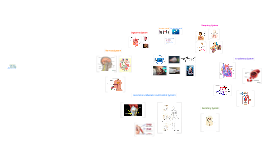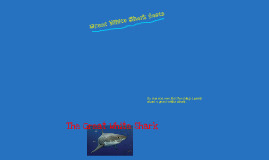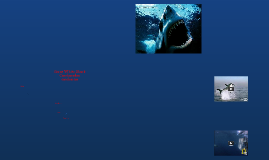Great White Shark
Transcript: Digestive System Anatomy- teeth, tongue, salivary gland, and jaw. Physiology- Breaking up of food using teeth. Anatomy- opening duct of salivary gland, saliva, amylase enzyme. Physiology- saliva contains enzymes that break down food The Human Esophagus Anatomy- tube connecting throat to stomach Physiology- use waves (peristalsis) to move food down to stomach The Human Stomach Anatomy- Esophageal Sphincter, Rugae, and Plyoric Sphincter Physiology- Stores food, Physically breaks down food into smaller particles, Chemically breaks down proteins using enzymes (pepsin),and releases food. The Small Intestine Anatomy- Absorption and Digestion of Nutrients. Physiology- Three sections: The duodenum, jejunum, and ileum. 19-22 feet long. The Human Liver Anatomy- Right Lobe, Left Lobe, Coronary Ligament, Falciform Ligament, and Ligamentum Teres. Physiology- Filter blood coming from degestive system Then Human Gallbladder Anatomy- Small pouch under the liver; the size of small pear. Physiology- Squeezes stored bile into small intestine to help digest fats. The Human Pancreas Anatomy- Two glands; Exocrine (digestive gland) and Endocrine (hormonal gland). Sits behind stomach. Physiology- Helps break down food in Duodenum and secretes hormones insulin and glucagon to regulate level of blood. Also secrets somatostatin. The Large Intestine Anatomy: About 5 feet long. Includes Cecum, Colon, Rectum, and Anal Canal. Located mostly in abdomen. Physiology: absorbs water from fecal material before it leaves body. The Human Ureters Anatomy: Paired muscular tubes (ducts) Physiology: Transport urine from kidneys to bladder The Human Bladder Anatomy: Muscular sac in pelvis, sits behind pubic bone. Physiology: Stores urine until urination. The Human Urethra Anatomy: Tube that leads to the outside of body. Physiology: Transports unine out of body from bladder Respitory System Nose (Nasal Cavity) Anatomy: external meatus, external nostrils, septum, nasal passages, and sinuses. Physiology: Acts as a filter. Warms and purifies air before passing it to the lungs. Larynx Anatomy: Upper opening into the windpipe, as seen as the "Adams Apple". Physiology: Acts as "voice box" and another passageway to lungs. Trachea Anatomy: The windpipe; extends from larynx down to the two bronchi. Physiology: Allows for large food to pass the esophagus and allows for breathing. Bronchi Anatomy: Tubular structure; stops in the lungs Physiology: Where oxygen enters the lungs. Alveoli Anatomy: Air sacs. Physiology: Site of gas exchange (oxygen and CO2). Respiration and the Diaphragm Anatomy: Muscle separating abdomen from chest cavity. Physiology: Contract when we breathe in and relax when we breathe out. Double Loop Anatomy: Pulmonary and Systemic Circulation Physiology: Circulates poor oxygen blood through lungs. Circulates rich oxygen blood everywhere in the body except lungs. Flow of Four Chambers of Heart Anatomy: Top two chambers are right/left atria and bottom two chambers are right/left ventricles. Physiology: Maintain blood flow into (atria) and out (ventricle) of heart. Heartbeats Anatomy: Pericardium (double layered membrane) surrounds heart; located between lungs and middle of chest. Physiology: Caused by contractions then relaxations; all caused by electrical impulses. Blood Vessels Anatomy: Arteries, Capillaries, Veins Physiology: Carry oxygen rich blood out of heart. Give cells oxygen and nutrients; removes CO2 and metabolic wastes. Transports blood poor of oxygen back to heart. Blood Anatomy: Plasma, Hemoglobin, Platelets. Physiology: Protects against infections, transports, and maintains homeostasis. Carry oxygen from lungs to tissue. Platelets form clots and scabs to stop bleeding from wound. Medulla Oblongata Anatomy: Located just above spinal cord. Physiology: Controls the Respiratory Center, Cardiac Center, Vasomotor Center, Sneezing, Coughing, Vomiting and Swallowing. Optic Lobe Anatomy: Located in the very back of the brain. Physiology: Connects to your eyes and allows you to see. Is also where dreams come from. Olfactory Bulb Anatomy: Located in limbic (emotional) part of brain. Located in back within cerebrum. Physiology: Allows for your sense of smell. Locomotion (Muscular and Skeletal System) Cartilage Anatomy: Dense connective tissue made of cells found between bones, nose, throat, and spinal column. Physiology: Provide site for bone growth, prevents bones from grinding together, and acts as a shock absorber. Joints Anatomy: Fixed (immovable), Cartilaginous (partially movable), and Synovial (move freely); ligaments Physiology: Make Skeleton Flexible. Cardiac Muscle (Heart) Anatomy: Makes up wall of heart. Physiology: Involuntary pumps blood throughout the body; never rests. Skeletal Muscle (Biceps) Anatomy: Located in upper arm (front). Physiology: Allows for movement of arm; contracts and relaxes. Great White's Taxonomy Animalia Kingdom Carcharias Locomotion System Anatomy: No bones; all cartilage. Physiology: Lighter, helps sharks

















